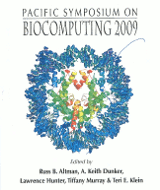A Bayesian Integration Model of High-Throughput Proteomics and Metabolomics Data for Improved Early Detection of Microbial Infections
Bobbie-Jo M. Webb-Robertson1, Lee Ann Mccue1, Nathanial Beagley1, Jason E. Mcdermott1, David S. Wunschel1, Susan M. Varnum1, Jian Zhi Hu1, Nancy G. Isern1, Garry W. Buchko1, Kathleen Mcateer1, and Joel G. Pounds1, Shawn J. Skerrett2, Denny Liggitt2, Charles W. Frevert2
1Pacific Northwest National Laboratory, Richland, WA 99352, USA; 2Pulmonary Research Laboratory, University of Washington, Seattle, WA 98108, USA
Pacific Symposium on Biocomputing 14:451-463(2009)

Abstract
High-throughput (HTP) technologies offer the capability to evaluate the genome, proteome, and metabolome of an organism at a global scale. This opens up new opportunities to define complex signatures of disease that involve signals from multiple types of biomolecules. However, integrating these data types is difficult due to the heterogeneity of the data. We present a Bayesian approach to integration that uses posterior probabilities to assign class memberships to samples using individual and multiple data sources; these probabilities are based on lower-level likelihood functions derived from standard statistical learning algorithms. We demonstrate this approach on microbial infections of mice, where the bronchial alveolar lavage fluid was analyzed by three HTP technologies, two proteomic and one metabolomic. We demonstrate that integration of the three datasets improves classification accuracy to ~89% from the best individual dataset at ~83%. In addition, we present a new visualization tool called Visual Integration for Bayesian Evaluation (VIBE) that allows the user to observe classification accuracies at the class level and evaluate classification accuracies on any subset of available data types based on the posterior probability models defined for the individual and integrated data.
[Full-Text PDF] [PSB Home Page]